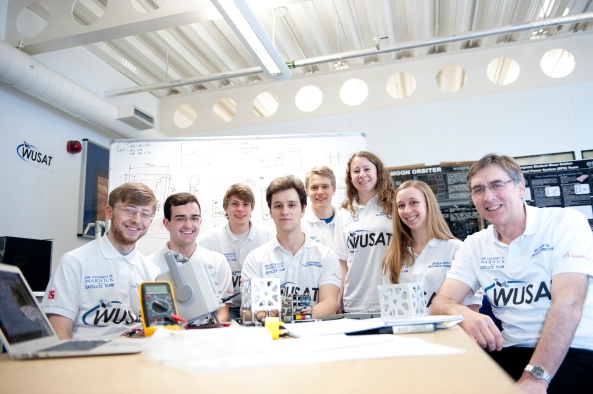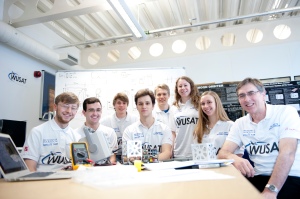
WUSAT Team
A team of University of Warwick engineering students are designing and building a CubeSat WUSAT2 which will be launched 100 km into space in 2015.
The third and fourth-year engineering students beat off stiff competition from undergraduate, post-graduate and PhD teams from all over Europe to be selected among the nine student projects to be taken into space by a European Space Agency (ESA) rocket in 2015.
The team, who are aged between 20 and 22, are building their own satellite known as WUSAT2 (Warwick University Satellite Team ) complete with electronics, communications and sensor systems which they are also constructing themselves.
As well as gaining the chance to work on cutting-edge technology and collaborate between various engineering disciplines, the students believe the process of building and launching the satellite will give them practical skills valued by employers once they have completed their courses at Warwick.
The satellite, which measures just 10 x 10 x 20 cm, will be launched by the ESA rocket REXUS, due to take off from Esrange (Swedish National Space Centre) in spring 2015.
Engineering student and WUSAT team member Chris Hanbury-Williams, from Andover in Hampshire, said: “As far as we are aware we are the only solely undergraduate team to have been chosen to launch their own experiment into space with ESA.
“Now we’ve been selected, our work has only just started. We have to design and build the satellite and all its electronic and communication systems – no mean feat seeing as the final satellite will measure just a few centimetres.
“But we’re all hugely excited about the launch as it’s not every day you get to take part in a space mission.”
Director of WUSAT Dr Bill Crofts said: “Being selected for the ESA launch is a great achievement on behalf of all the students in the group.
“We want our engineering students to get hands-on experience of working on the kinds of projects they will be working on when they go out into the working world after graduation.
“Students from different engineering disciplines – such as manufacturing, electronics and mechanical engineering – all work together as they would in a real-life working environment.
“It’s this experience, as well as the engineering knowledge the students are gaining, that is very valuable to employers.”
Professor Nigel Stocks, Head of the School of Engineering, said: “This is a remarkable achievement that reflects the talent and commitment of the School’s undergraduate students and outstanding leadership by Dr Crofts.
“The School of Engineering’s integrated approach to education enables multidisciplinary teams such as WUSAT2 to develop exciting and highly ambitious projects that few UK University’s can match.”
The launch gives other departments within the university the opportunity to carry out experiments as the satellite descends from its launch altitude of 100km back down to Earth above the Arctic Circle.
For the 2015 launch, WUSAT will carry an experiment suggested by a team of physicists at Warwick who hunt for planets outside our solar system and analyse their atmospheres.
The satellite will be carrying a simple way of looking at gases such as oxygen and sodium by measuring the brightness of sunlight at some very specific colours and at different heights as the satellite falls back to Earth.
This kind of data is useful in studying planets that are outside our solar system (known as exoplanets) as it will help astronomers better understand the composition of their atmospheres and potentially decide whether they are possible candidates to house life.
The Warwick Satellite Team is a long-running project within Warwick’s School of Engineering which has seen successive teams working on the design and build of satellites over the last eight years.
The team spent six years designing the electrical power supply system for ESA’s ESMO satellite – designed to orbit the moon – and they are now in their second year of designing and building Warwick’s own WUSAT satellite.
Last year’s team of students succeeded in launching a similar satellite (WUSAT1) 30 km above the earth’s surface using a balloon launch.
The industry sponsors of the WUSAT project are Chemring Group, Lyncolec, Solidworks, Thales, National Instruments, ESATAN-TMS, Harwin and RS.
For further information please contact
Dr Bill Crofts on w.e.crofts at warwick.ac.uk
WUSAT on Facebook https://www.facebook.com/WarwickUniversitySatellite






You must be logged in to post a comment.